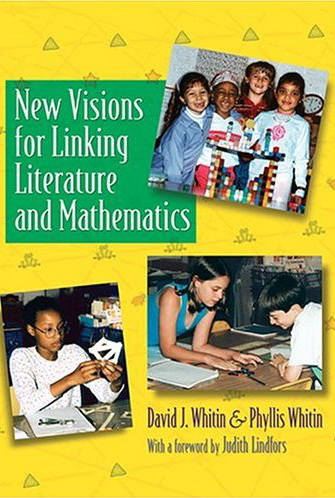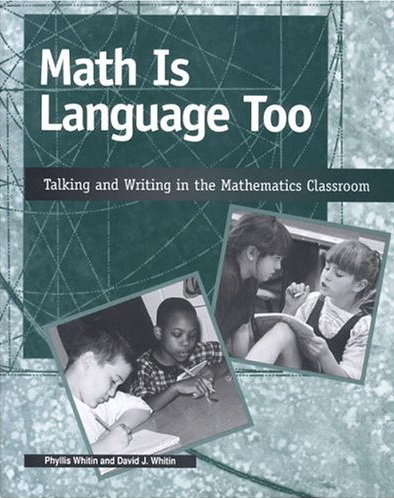David J. Whitin (pictured above) teaches mathematics education in the Elementary Education Department at Wayne State University.
Degrees and Certifications
Baccalaureate: Princeton University, 1970, BA, Classics
Graduate: Boston University, 1971, MA, (Art History)
University of New Hampshire, 1972, MAT, (Elementary Education)
Indiana University, 1984, EdD, (Elementary Education)
Phyllis E. Whitin (pictured above) teaches language arts education courses in the Elementary Education Department at Wayne State University.
Degrees and Certifications
PhD, Elementary Education, University of South Carolina, 1993
MAT, Elementary Education, University of New Hampshire, 1972
B.A., Religion, Bates College, Lewiston, Maine, 1970
Learning to Read the Numbers: Integrating Critical Literacy and Critical Numeracy in K-8 Classrooms (2010)
 Learning to Read the Numbers is a co-publication of The National
Council of Teachers of English (www.ncte.org) and Routledge. This book is
published by — and available from —
Routledge, Taylor and Francis Group.
Learning to Read the Numbers is a co-publication of The National
Council of Teachers of English (www.ncte.org) and Routledge. This book is
published by — and available from —
Routledge, Taylor and Francis Group.
Back Cover
Being a critical reader of numerical information is an integral part of being literate in today's data-drenched world. Uniquely addressing both mathematics and language issues, this text shows how critical readers dig beneath the surface of data to better evaluate their usefulness and to understand how numbers are constructed by authors to portray a certain version of reality. Engaging, concise, and rich with examples and clear connections to classroom practice, it provides a framework of critical questions that children and teachers can pose to crack open authors' intentions, expose their decisions, and make clear who are the winners and losers—questions that are essential for building democratic classrooms.
Explaining and illustrating how K-8 teachers can engage students in developing the ability to be both critical composers and critical readers of texts. Learning to Read the Numbers is designed for teacher education courses across the areas of language arts, mathematics, and curriculum studies, and for elementary teachers, administrators, and literacy and mathematics coaches.
PREFACE:
It is our conviction that the integration of language and mathematics has profound implications for fostering a critical perspective in our schools. In this book we show that when numbers are embedded in an argument or used as a policy justification, people are often reluctant to question them. We surmise that this genuflecting before numerical information is due to people's learned trust in numbers. "Who am I to question the 'facts?'" some might ask.
To counter this prevailing attitude, we argue that mathematical information is a human construct, and not a sacrosanct edifice of unassailable truths. Just like language, data should be interrogated. Yet numbers have this abstract, scientific, apolitical aura that often makes them impervious to challenge and debate. This perception about the nature of mathematics has concerned us for some time. In our book we endeavor to make this problem explicit and to show that children, even young ones, can begin to understand that since numbers are constructed they can also be questioned, challenged. and revised.
In Chapter 1 we outline the pervasiveness of statistical texts in our world: and advocate the cultivation of critics who analyze and evaluate these texts. We support this argument by citing researchers in the field of language' and mathematics who urge the development of this critical thinking. We introduce a model and a heuristic that describe different aspects of the data- gathering process and that offer a critical frame for interrogating data-infused texts.
In Chapter 2 we examine in more depth how the wording and format of a question in a survey can affect the results. We discuss the complexities within seemingly “simple” questions, and show how motives, ideology, and other social factors are embedded in the questions one poses.
The issue of the definition of terms and the categorization of the data are the focus of Chapter 3. We argue that how one defines a term, such as homelessness or unemployment, determines what gets counted, and it is through these definitions that authors of texts construct their version of reality that positions others to view the world in particular ways. Decisions that authors also make about which categories to use, omit, or combine play a significant role in concealing some relationships and revealing others.
In Chapter 4 we show that visual texts, just like any form of communication, are not neutral but reflect an author's interests, values, and beliefs. Since there is no one-to-one correspondence between a set of data and its visual referent, authors have choices about how to represent those data. Their decisions about the visual display of the data can clarify some ideas and obfuscate others. We illustrate the power of this decision-making by exploring how alternative ways to display the same data can tell quite different stories.
In Chapter 5 we highlight how any report of statistical information is only a partial account. When choices are made about data some information is always sacrificed. We discuss limitations, such as the nature of the sample, the relationship between results and conclusions, and the potential benefits and drawbacks to certain mathematical choices. Some of these mathematical choices include deciding whether to use absolute or relative (ratio) data; or to express average through the mean, median or mode. Each choice can frame an issue or problem from a different perspective.
Finally, in Chapter 6 we show how the integration of critical literacy and critical numeracy develops over time as a group of fifth-grade students gathered data about television advertisements directed at children. They researched marketing strategies, gathered data about cereals, and constructed survey instruments for their peers. They used their analysis of those data to create an informational PowerPoint presentation for their classmates and to write letters of protest to politicians and governmental and corporate agencies.
Throughout the book we present examples of children's work as well as examples from the media. In this way we show how the same critical issues permeate the construction of all texts. Children are doing the real work of any author as they grapple with the same problems, negotiate the same tensions, and confront the same limitations. Ideology and motives are always embedded in the work. The personal interests and intentions that even young children have about their social worlds are mirrored in the same way by companies and governmental agencies.
Another important idea threaded throughout this book is that children must be both critical composers as well as critical readers of texts. We argue that this ability begins with teachers giving children regular opportunities to create their own data-infused texts. As children confront the challenges of posing questions, defining terms, categorizing the data, and creating a visual representation, they come to understand the complexities of the task. They also come to realize that all these choices they have affect the results they receive, and this choosing is a form of power and control. Only as they experience these insights as authors themselves can they use this perspective to critique the statistical claims of others.
We wrote this book for classroom teachers K-8 as well as university instructors who teach classes in curricular issues, critical literacy, as well as the content areas of mathematics, English language arts, social studies, and science. We intend the book for several audiences because we view this critical stance as a perspective that cuts across all grades and all areas of the curriculum. It is work that every educator must be involved in if we are to create the kind of democratic schooling that the twenty-first century demands.
TABLE OF CONTENTS
| 1 | Learning to Read the Numbers: It's Everybody's. Business | 1 |
| 2 | Getting What You Ask For: Examining the Question | 22 |
| 3 | Definitions and Categories: Deciding What Gets Counted | 41 |
| 4 | Creating the Visual: Playing Statistical Hide and. Seek | 59 |
| 5 | What We Don't Know: Critiquing the Sample and the Conclusions | 82 |
| 6 | Learning to be Critics: Case Study of Children's Television Advertising | 102 |
Back Cover Reviews and Comments:
“Facts don't exist anymore. What counts these days is what story you can spin. To the extent that this is so, all the more reason to prepare critically literate individuals and what more effective place to start than with mathematical literacy. Even I might have loved math if I had known how to use it to make a more just and equitable world! Bravo to the Whitins for once again showing us how to add things up this right way!” — Jerome C. Harste, Indiana University
“It is never too early to involve learners in high-interest, real-world, information-gathering activities that challenge them to analyze language and interpret data. This book makes an important contribution to elementary reading and mathematics, providing ideas for developing critical literacy skills by engaging learners in language and data analyses, and encouraging them to use data in make social-action decision.” — Frances R. Curcio, Queens College of the City University of New York.
“Not only do the Whitins show us why numbers need to be interrogated, they also demonstrate how to teach young children not to take numbers at face value. For example, from conducting their own surveys, children learn that information that is quantified is tied to the questions that are asked. This book offers an important new dimension to critical literacy.” — Hilary Janks, University of the Witswatersrand, South Africa
“Through the use of classroom examples the Whitins breathe new life into numeracy work by re-framing it from a critical literacy perspective. Working to disrupt commonplace beliefs about the apolitical nature of mathematics, this book brings us closer to understanding that we claim to be true or real about mathematics is in fact mediated through Discourse and there never neutral. A must read for K-8 teachers!” — Vivian Vasquez, American University, Washington DC.
Questions to Support a Critical Orientation toward Statistics:
| Features | Critic's Perspective | Questions to Consider |
|---|---|---|
| 1. The Social Context | The researcher's motives, the setting, and the status of participants influence all aspects of the process. |
What is your purpose for collecting this information? Who is your audience? How are you collecting this information? |
| 2. The Question | The way a question is posed influences the kinds of responses one receives. |
How did you ask your question? Why did you ask it in that way? How might this language have influenced the responses you received? What groups of people did your question privilege? Silence? How else might the question have been worded? |
| 3. The Definitions | Broad or narrow definitions determine what gets counted. The choice of words reflects the intentions of the author. |
How did you define this word? Why did you define it this way rather than another way? What groups of people did your definition or choice of words privilege? Silence? |
| 4. The Categories | Data can be aggregated or disaggregated to serve one's purposes. |
How were the categories decided upon? What happened to responses that did not fit into these categories? In what other ways might you categorize these data? What information is lost by using these categories? |
| 5. The Visual Representation | Displays can reveal and conceal certain layers of information. |
Why did you decide to show your information in this way? What information is concealed/ revealed by this form of representation? Who benefits from representing the data in this way? How else could you have displayed your data? |
| 6. The Sample | The knowledge, background, interests and biases of the sampled population influence their responses. |
Who did you ask? How informed was the sampled population about this topic? What might have happened if you had asked a different group of people? |
| 7. The Conclusions | Conclusions are based upon the assumptions of the researchers. |
How are your results different from your conclusions? What conclusions can't we make? How might your choice of a mathematical concept (ratio, average) influence your audience's thinking? |
New Visions for Linking Literature and Mathematics
 Customer Review:
Customer Review:
This is a useful resource for teachers looking to bring literature into their math classrooms. Most of the content of this book focused on ideas for grades K-6, primarily the younger grades. I am most interested in the middle grades (6-8), so I would probably need to make accommodations to “beef up” the activities, but this book still gave great insight. The book is divided into several sections on useful topics such as the book selection process, appealing to different age groups, and book pairings. The section that stood out the most to me was the first chapter: Criteria for Selecting Math-Related Books. This is a section that every teacher could benefit from reading. Without giving too much away, the chapter examines the National Council of Teachers of Mathematics (NCTM) principles and standards for classroom literature. It takes into account many aspects of effective classroom literature, including accuracy of ideas, clarity, and cultural awareness. A strong point of this book is its careful attention to the NCTM standards. If you follow its ideas outlined on choosing literature, then you would be almost guaranteed to find success in your classroom. I will point out that this book is largely made up of example activities for specific books. Bearing that in mind, this work would be best for teachers looking for specific titles to use in their classroom. Teachers interested in the science and process behind choosing appropriate reading material for their classroom might want to glimpse through this book rather than read it fully.
Math Is Language Too: Talking and Writing in the Mathematics Classroom
 Product Description
Product Description
The stories in this book describe events that took place over a period of four years in a fourth-grade classroom where children of varying academic abilities were encouraged to develop a spirit of inquiry through writing and talking. This book is about how to build a mathematical community that honors all voices and uses writing and talking to uplift these voices and enrich mathematical ideas.
Recent Presentations
- Developing a critical orientation toward data Whitin, D. J. & Whitin, P. (November 2008) National Council of Teachers of English, San Antonio, TX.
- Critiquing data in democratic classrooms Whitin, P. & Whitin, D.J. (April 2008) National Council of Teachers of Mathematics, St. Lake City, UT.
- Strategies for developing a critical orientation toward statistics Whitin, D. J. & Whitin, P. (November 2007) National Council of Teachers of English, New York, New York.
- Strategies for integrating poetry and mathematics Whitin, P. & Whitin, D.J. (November 2006) National Council of Teachers of English, Nashville, TN.
- New visions for linking literature and mathematics Whitin, D.J. & Whitin, P. (May 2006) International Reading Association, Chicago, IL.
- Learning to talk back to a statistic Whitin, P. & Whitin, D.J. (April 2006) National Council of Teachers of Mathematics, St. Louis, MO.
- Strategies for promoting the book-pair strategy in mathematics Whitin, D.J. (November 2005) National Council of Teachers of English, Pittsburgh, PA.
- New visions for linking literature and mathematics Whitin, P. & Whitin, D.J. (April 2005) National Council of Teachers of Mathematics, Anaheim, CA.
Recent Publications
Books:
- Whitin, D. J. & Whitin, P. Learning to read the numbers: Quantitative literacy in k–8 classrooms. New York: Routledge.
- Whitin, D. J., & Whitin, P. (2004). New visions for linking literature and mathematics Urbana, IL: National Council of Teachers of English and Reston, VA: National Council of Teachers of Mathematics.
- Whitin, P. & Whitin, D. J. (2000). Math is Language Too: Talking and Writing in the Mathematics Classroom. Urbana, IL: National Council of Teachers of English and Reston, VA: National Council of Teachers of Mathematics.
- Whitin, P. & Whitin, D.J. (1997). Inquiry at the Window: Pursuing the wonders of learners. Portsmouth, NH: Heinemann Books.
- Whitin, P. (1996). Sketching stories, stretching minds: Responding visually to literature. Portsmouth, NH: Heinemann Books.
Book Chapter:
- Whitin, P. & Whitin, D.J. (2009). Developing effective mentoring skills for mathematics coaches. In G. Zimmerman (Ed.). Empowering the mentor of the experienced mathematics teacher: pp.26–28. Reston, VA: National Council of Teachers of Mathematics; and Empowering the mentor of the beginning mathematics teacher: pp.28–29. Reston, VA: National Council of Teachers of Mathematics, and Empowering the mentor of the preservice mathematics teacher, pp. 34–35. Reston, VA: National Council of Teachers of Mathematics.
- Whitin, P. (2004). Enlarging the learning community through family mathematics. In Rubenstein, R. (Ed.). Perspectives on the teaching of mathematics. (2004 NCTM Yearbook, pp. 117–128). Reston, VA: National Council of Teachers of Mathematics.
Articles:
- Whitin, P. (2009). Tech-to-stretch: Expanding possibilities for literature response. The Reading Teacher, 62(5), 408–418.
- Whitin, D. J. & Whitin, P. (2009). Legs and more legs. Teaching Children Mathematics, 16 (2), 80–87.
- Whitin, D.J. & Whitin, P. (2009). Why are things shaped the way they are? Teaching Children Mathematics, 15 (8), 464–472.
- Whitin, P., & Whitin, D. J. (2008). Learning to read the numbers: A critical orientation toward statistics. Language Arts, 85 (6), 432–441.
- Whitin, P. & Whitin, D. J. (2008). Learning to solve problems in the primary grades. Teaching Children Mathematics, 14 (7), 426–432.
- Whitin, P. (2007). Ties that bind: Emergent literacy and scientific inquiry. Language Arts, 85 (1), 20–30.
- Whitin, P. (2007). The mathematics survey: A tool for assessing attitudes and dispositions. Teaching Children Mathematics, 13(8), 426–433.
- Whitin, P. (2006). Meeting the challenges of negotiated mathematical inquiry. Teaching & Learning: The Journal of Natural Inquiry and Reflective Practice, 21 (1), 59–83.
- Whitin, P. (2005). The interplay of text, talk, and visual representation in expanding literary interpretation. Research in the Teaching of English 39 (4), 365–397.
- Whitin, P. & Whitin, D. J. (2005). Pairing books for children’s mathematical understanding. Young Children 60 (2), 42–48.
- Whitin, P. (2004). Promoting problem-posing explorations. Teaching Children Mathematics 11(4), 180–186.
- Whitin, D. J. & Whitin, P. (2003). Building a community of mathematicians. Teaching Children Mathematics 9 (8), 464–469.
- Whitin, P., & Whitin, D. J. (2003). Developing mathematical understanding along the yellow brick road. Young Children. 58 (1), 36–40
- Whitin, D. J. & Whitin P. (2003). Talk counts: Discussing graphs with young children. Teaching Children Mathematics 10, (3), 142–149.
- Whitin, P. & Whitin, D. J. (2002). Promoting communication in the mathematics classroom. Teaching Children Mathematics 9 (4), 205–211.
- Whitin, P. (2002). First flight: Introducing the natural world to kindergarten children through a yearlong study of birds. Science and Children, 39 (4), 16–21.
- Whitin, P. (2002). Leading into literature circles through the sketch-to-stretch strategy. The Reading Teacher, 55 (5), 444–450.
- Whitin, P. (2001). Kindness in a jar. Young Children, 56 (5), 18–22.
- Whitin, P. (2000). Using imagery to respond to African-American Literature. The Dragon Lode, 18 (2), 30–34.


